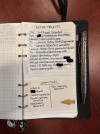I can see how that works in something linear where each action follows the previous action. But what about when a project has multiple actions that (seemingly) can happen simultaneously -- I have many of these.
I may kill your example, but in the same project, I will need some equipment (e.g., swim goggles), songs to run to, someone to drive me to the start, and maybe some special food. In my mind, each one of these is a NA and there's no particular order they need to happen in. And I don't want to lose any of them and I want to keep them all near top-of-mind. What would you do about choosing just one to put on your NA list. If I choose to do one of them first, what happens to the other items?
I see a few options--assuming this is "one action per project" situation:
- You could have a project plan. This is a separate entity from your project-and-context lists. You choose a next action from the project plan, and then either when it's done or in the first weekly review after it's done, you choose the next one.
- You could have multiple projects. If I had to select and buy swim goggles, that would be a project. If I just had to remember to pack them, not so much.
- Your project could interact with a list. (This is similar to the project plan.) So you have an action, "Create packing list for event." Then, after a WAITING FOR period, you have an action, "Pack for event from packing list."
I'm sure there are other possibilities.


